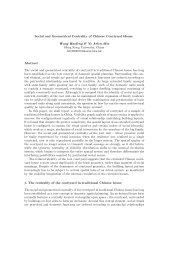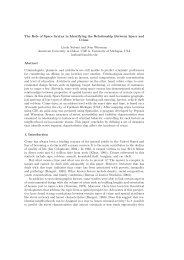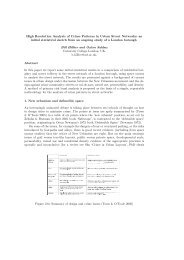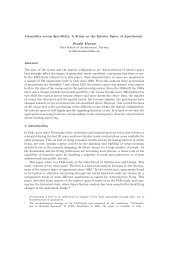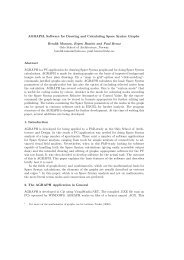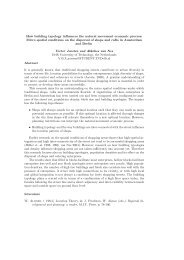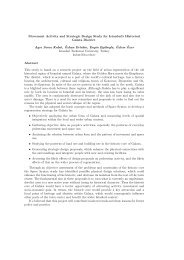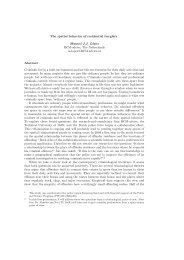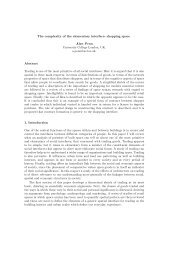Space Syntax in Maya Architecture Annegrete Hohmann-Vogrin ...
Space Syntax in Maya Architecture Annegrete Hohmann-Vogrin ...
Space Syntax in Maya Architecture Annegrete Hohmann-Vogrin ...
Create successful ePaper yourself
Turn your PDF publications into a flip-book with our unique Google optimized e-Paper software.
282 <strong>Annegrete</strong> <strong>Hohmann</strong>-Vogr<strong>in</strong><br />
everyth<strong>in</strong>g that can be seen now was actually there at one po<strong>in</strong>t. This is the only stage<br />
we can reconstruct to represent the whole area (figure 119). The difficulties <strong>in</strong> describ<strong>in</strong>g<br />
the agglomerations of structures that are the results of frequent overbuild<strong>in</strong>g soon led to<br />
the realization that monumental build<strong>in</strong>g groups, which can be found <strong>in</strong> the core areas<br />
of ancient <strong>Maya</strong> cities, are among the best examples to demonstrate or understand the<br />
space-creat<strong>in</strong>g function of architecture, and that the description has to focus on the spatial<br />
configuration. Plazas, courtyards and causeways, platforms and terraces, were def<strong>in</strong>ed<br />
as the pr<strong>in</strong>cipal constituent elements (figure 120). Adequate documentation and analysis<br />
shall cover not only their specific spatial context, but also the structure of the cont<strong>in</strong>uous<br />
space thus created. On that basis, an <strong>in</strong>terpretation may focus on different aspects, for<br />
<strong>in</strong>stance on aspects concern<strong>in</strong>g physical control, or on aspects of cultural symbolization,<br />
as long as the analysis was not designed to answer only one question.<br />
Physical control addresses the reaction of the built environment to the specific environmental<br />
conditions: heat or cold, flora and fauna, heavy ra<strong>in</strong>s, water supply, transportation<br />
resistances, and availability of build<strong>in</strong>g materials. It has been shown that, to<br />
a certa<strong>in</strong> degree, the specific shape and layout of <strong>Maya</strong> settlements could be expla<strong>in</strong>ed<br />
only through these facts (<strong>Hohmann</strong>-Vogr<strong>in</strong>, 1998). In the same way, the built environment<br />
can also be an expression of cultural symbolization, represent<strong>in</strong>g the specific worldview<br />
of the <strong>Maya</strong> (<strong>Hohmann</strong>-Vogr<strong>in</strong>, 2000). Both approaches explore the <strong>in</strong>tentions beh<strong>in</strong>d the<br />
way the <strong>Maya</strong> built their world, and how they are reflected <strong>in</strong> the ultimate configuration<br />
of that world. In this field, my conclusions were drawn ma<strong>in</strong>ly on the basis of structural<br />
similarities supported by other archaeological, ethnographic, and epigraphic sources.<br />
The other - <strong>in</strong>timately related - questions address the effect of the built environment<br />
on human be<strong>in</strong>gs, i.e. how it could have been perceived at the time when it was <strong>in</strong> use,<br />
and whether this can tell us someth<strong>in</strong>g about the functional frame and the social milieu<br />
it generated.<br />
We may assume that it is aga<strong>in</strong> the overall configuration that determ<strong>in</strong>es: -functional<br />
possibilities of a specific area, as this def<strong>in</strong>itely depends on its position <strong>in</strong> the fabric as a<br />
whole, and - the social milieu, as this is constituted by the potential of space to generate<br />
mutual awareness and encounters.<br />
Most likely, the attempt to answer these questions still seems rather ambitious. I<br />
already tried to approach the first question <strong>in</strong> my dissertation, published later <strong>in</strong> “Die<br />
Architektur von Copan” (<strong>Hohmann</strong> and Vogr<strong>in</strong>, 1982). I sought to determ<strong>in</strong>e the centrality<br />
of the different areas <strong>in</strong> the Ma<strong>in</strong> Group <strong>in</strong> Copan, of plazas or courtyards, <strong>in</strong> comparison<br />
with their accessibility (<strong>Hohmann</strong> and Vogr<strong>in</strong>, 1982, p. 91), based on a method proposed<br />
by Norman Hammond <strong>in</strong> his work on Lubaantun (Hammond, 1975, p. 78-83). This was a<br />
rather simple and rough approach.<br />
S<strong>in</strong>ce the publication of “The social Logic of space” (Hillier and Hanson, 1984), my plan<br />
had been to apply space syntax concepts to <strong>Maya</strong> urbanism. At first sight, especially the<br />
concept and def<strong>in</strong>ition of “convex space” was appeal<strong>in</strong>g and suitable <strong>in</strong> the context of <strong>Maya</strong><br />
towns, but differences turned out to prevail. Hillier and his colleagues have <strong>in</strong>vestigated<br />
ma<strong>in</strong>ly the old European cities, or what he and we would designate as “normal cities”,<br />
def<strong>in</strong>ed as variations of the follow<strong>in</strong>g:<br />
“Build<strong>in</strong>gs are arranged <strong>in</strong> outward-fac<strong>in</strong>g blocks so that build<strong>in</strong>g entrances cont<strong>in</strong>uously<br />
open to the space of public access. The space of public access is arranged <strong>in</strong> a series<br />
of <strong>in</strong>tersect<strong>in</strong>g r<strong>in</strong>gs that are regularized by a greater or lesser degree of l<strong>in</strong>earization of<br />
space to form the - more or less deformed - grid of the town. Through this l<strong>in</strong>earization<br />
the larger-scale structure of the town is made <strong>in</strong>telligible both to the peripatetic <strong>in</strong>dividual



